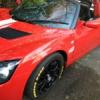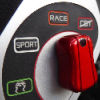I am going to have to dissagree with the comments of engine braking hindering the cars performance - it's absolutely essential. If you're unsettling the car or doing it too early, you're doing it wrong, very wrong. Don't forget that heel-toe is also essential if you're engine braking. The limitger does not protect the engine on down shift. Not heel-toeing means you run a real risk of buzzing the engine.
You say you disagree, but the purpose of H + T can be to minimise engine braking. The finest exponent of H + T will minimise engine braking to zero.
H + T is to match engine speed in the lower gear to road speed. The clutch comes up when the engine speed matches road speed perfectly, so no engine braking. Looking at it the other way, if you wanted to maximise engine braking, you would downshift as soon as the brakes had removed enough road speed for you to engage the lower gear at maximum engine revs, no H + T involved.
Best practical illustration I have had was driving one of Johhnie Palmer's Clio Cups in the wet. Anything other than a perfect H+T locked the fronts, which remained locked until I was out of brakes. Fortunately, I consider FWD to be the work of the devil and avoid wherever possible.
(BTW, H+T dooes not protect the engine from being buzzed. If you've got the wrong gear for roadspeed, that engine will buzz whether you've H+Td or not.




















